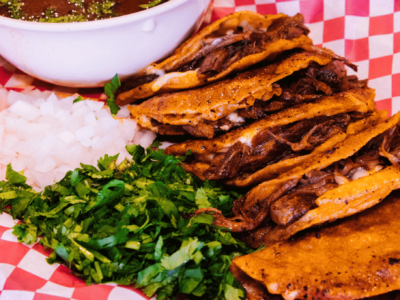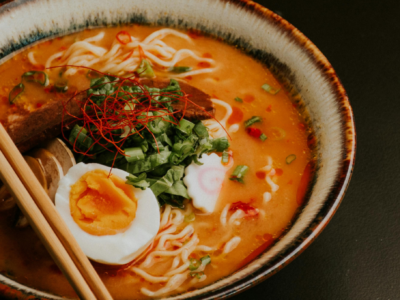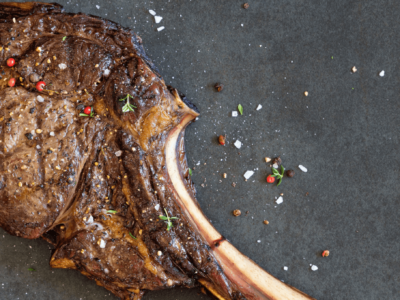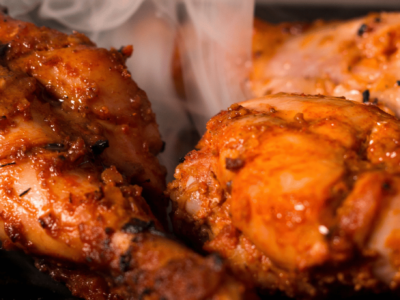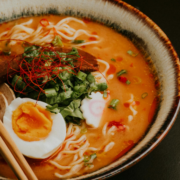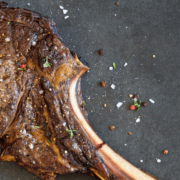Osaka vs Tokyo – the debate you thought would never happen! While we are going to talk largely about Osaka, we are going to discuss how Tokyo’s food is also gaining popularity really fast. And Osaka’s food industry is worried.
Considering Tokyo’s dominance as one of the biggest megacities globally, Osaka comes with its own set of defenders.
And we are on a team of defenders. In the end, it literally comes down to visiting Japan with a certain amount of time – do you have enough time to check out both Tokyo and Osaka? If you ask us, we would say ‘yes!’
Just to give you some context, we spent a month in Tokyo and then another month in Osaka – yes, it took us 60 days to explore these two regions of Japan in detail, finding places to check out and food to explore.
If you are here, chances are that you are trying to figure out which place to visit. But if you ask us, you can either go for both or just go to Osaka!
Moreover, there is no point denying that Japan is a food lover’s paradise, especially if you are a sucker for traditional Japanese food. First, we were blown over by Kyoto’s dedication to local food. Then, in the next couple of months, Tokyo and Osaka had a chance to impress us.
To be honest, we were impressed. When it comes to food, Japan is the epitome of balance and taste.
So, without wasting time, let’s find out the best food that you can’t miss out on in Osaka and Tokyo. Also, why is visiting Osaka so much better than visiting Tokyo?
Contents
But First, Kanto vs Kansai: What Is This Food War All About?

While the Osaka vs. Tokyo debate is relatively new to most people, the Kanto vs. Kansai debate never gets old for people living in Japan.
While Kanto is the major eastern area of Japan, home to the capital city of Tokyo and 6 other districts, Kansai is in the western part of the same country. Japan’s western region is home to both Kyoto and Osaka, as well as five other districts.
Naturally, both these regions have their own kind of rivalry that goes back centuries. Historically, Kansai was home to Japan’s emperor and wealthy merchants, whereas Samurais used to dominate the Kanto region, not to mention the reigning shotgun of the country.
At present, the samurais have actually given way to salaried employees. But you will still be able to spot the main differences between Kanto and Kansai every time you go to a restaurant for a meal. Generally, Kanto cuisine is saltier, bolder, and richer, whereas Kansai food is sweeter and milder.
Moreover, you will come across many seafood dishes in the capital, but in Kyoto, you will find a wider range of vegetables. Whether it’s round vs. triangular onigiri or monjayaki vs okonomiyaki, the Kansai vs. Kanto rivalry is really pronounced inside the kitchen.
So, here’s a brief overview of the basic differences between Osaka and Toyko in terms of food.
Let the food wars begin – Osaka vs Tokyo!
1. Light vs. Dark Broth for noodles:
In the Kanto region, you can have fun slurping up a blackish, strong broth. It is a blend of katsuo-dashi and Koikuchi. While katsuo dashi is a stock made with delicious bonito fish flakes, koikuchi is a sort of dark soy sauce.
However, in the Kansai region, the stock is clear, golden, and much lighter. Here, it is made from kombu dashi, a seaweed-based stock, and light soy sauce known as utsukuchi.
Such a difference might have begun because the dark broth tastes better when consumed with soba noodles, a popular Kanto food, but the light broth goes better with udon noodles, which are common to the Kansai region.
2. Veggie Tempura vs. Seafood Tempura:
If you love tempura sauce, then you will love what Tokyo has to offer.
Traditionally, in the Kanto region, tempura is made with seafood, fried deep in sesame oil, and finally served with a dark soy sauce and dashi sauce.
Similarly, in Western Japan, traditionally, tempura is cooked with vegetables—even vegetable oil is primarily used. The food is served with salt so as not to overpower the delicate flavors of the veggies.
3. Round vs. Triangular Onigiri:
Of course, you have heard about Onigiri, Japan’s most common snack. You will literally find them across the country in konbini, shaped into balls or triangles. However, in the distant past, the shapes varied from region to region.
So, the onigiri from Tokyo were in the shape of triangles because Samurais used to find it easy to carry them. But in Kansai, going to the theater used to be a popular activity. In fact, plump and round onigiri would neatly fit into bento boxes that people would carry with them to the theatres.
4. Square Sushi vs. Nigiri Sushi
We love sushi – and if you love sushi as well, then you obviously know about nigiri sushi. Also known as edomae sushi, Nigiri sushi is made with seafood that is easily available from Tokyo Bay. FYI, Tokyo’s old name used to be Edo, while ‘mae’ stands for ‘in front of.’
Once Tokyo became Japan’s capital, the city witnessed a massive migration of workers. The appearance of busy workers in the city led to the growth of the fast food industry. Naturally, at the time, fresh seafood and rice served together appeared to be the ideal solution.
In Kansai, on the other hand, people would typically carry sushi home instead of eating it outside. In fact, there weren’t any refrigerators. As a result, people used to press the rice and its toppings inside a box together – so that it was easy to preserve and ready for commute.
Moreover, this type of pressed sushi was called oshizushi.
7 Best Food Options In Osaka:
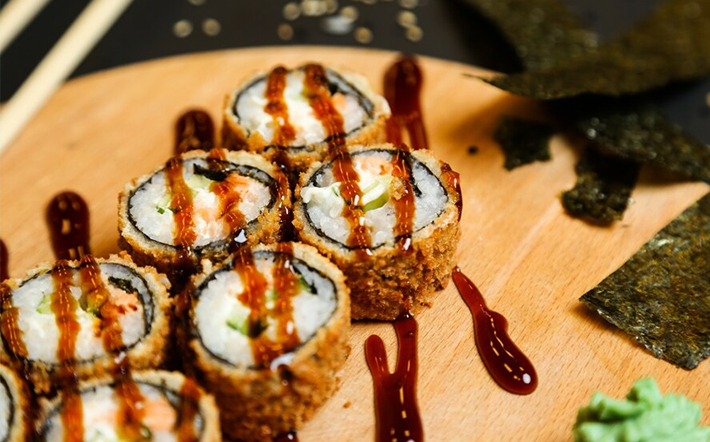
We were able to highlight the primary differences between Tokyo’s and Osaka’s cuisines. Tokyo is the capital of Japan, and it has evolved into a cosmopolitan city where you are bound to find everything — the best of Japan.
But Osaka hits differently—that’s the magic of going to places for their own individual USP. For instance, Kyoto is known for its traditional Buddhist dishes, Kobe is known for its local brand of beef, and Yokohama is known for housing the largest Chinatown in the world.
Similarly, Osaka is known for its fresh ingredients. While fresh seafood comes from the Seto Inland Sea and Osaka Bay nearby, the surrounding farmlands produce fresh and seasonal vegetables.
Interestingly, did you know that Osaka’s nickname is Tenka no daidokoro, A.K.A., the nation’s kitchen? Yes, the city got its nickname from history. A few centuries ago, Osaka was one of Japan’s most important cities in the rice trade, but the nickname has continued to stay relevant even after all these years.
Moreover, the city has another nickname – with its delicious cuisine, it’s not a shocker that Osaka’s nickname is Kuidore. FYI, Kuidore means bankrupting yourself
With such tempting cuisine, it’s no wonder that the other phrase associated with Osaka is kuidore, to bankrupt yourself by spending money on food and drink.
On our trip to Osaka, we tried out pretty much everything, and after much thought, here are 7 best foods to try in Osaka!
1. Oshi-Zushi:
Osaka-style sushi or oshi-zushi is hard to find – often eclipsed by the more popular nigiri sushi hailing from Tokyo. But it is definitely worth seeking out since it literally dates back almost 400 years. Yes, it is one of the oldest sushi varieties in the world, and it is still eaten.
FYI, oshi-zushi is also called box sushi or hako-zushi. It’s a kind of pressed sushi made by pressing ingredients and vinegared rice into a box-shaped mold. In this case, the sushi toppings typically range from common fishes such as sardines and mackerels to more premium and decorative ingredients such as sea bream and prawns.
Also, while nigiri sushi is famous for its quick preparation, oshi-zushi takes hours to make. This is because you have to give time for the flavors of rice and fish to infuse together.
2. Kushikatsu:
In Osaka, Kushikatsu is the epitome of cheerful and cheap dining! We loved eating the many skewers of meat, seafood, and vegetables – all breaded first and deep-fried until their shells turn golden and crisp.
Moreover, the restaurants are casual, with only enough space to stand. Plus, these restaurants serve Kushikatsu with large glasses of highballs and ice-cold beer. That way, you can enjoy some delicious food with some cold beer in a lively and vibrant atmosphere.
Also, the other notable feature of such dining is the all-you-can-eat piles of fresh and crunchy cabbage that often accompanies the food. But what could a few pieces of cabbage do? It can aid your digestion, for starters.
We also loved the barbecue-style sauce to dip the skewers in. There’s only one golden rule — you can’t dip it twice!
Our recommendation: prawn, pork belly, shiitake mushroom, and lotus root kushikatsu.
3. Kitsune Udon:
Just like ramen, udon noodles have their own flavors that vary from region to region in Japan. In fact, the native Udon noodles that you will find in Osaka are Kitsune Udon. It’s a sort of delicate broth made from chewy udon noodles, fish-based dashi, sweet-and-savory deep-fried tofu (abura-age), and seaweed.
In the 1890s, a sushi chef became a restaurant owner who wanted to serve udon noodles with tofu pockets he had originally kept for making inari sushi.
But since he felt like making something new and unique, he started serving udon noodles with these tofu pockets. The bowls were an instant hit, making them one of the most popular udon noodles in Japan.
4. Tessa (Fugu):
Japanese blowfish fugu is known as Tessa in Osaka’s local dialect. Interestingly, Tessa is also slang for ‘gun’ – a reference to the fish’s lethally toxic liver. As a result, if you are not able to prepare fugu right, then eating it would be equivalent to playing Russian roulette.
In Osaka, fugu is very popular – it’s caught in the waters between Kyushu and Osaka, and 70% of the catch is eaten alone.
One of the best dishes made with this fish in Osaka is called Fugu Sashimi – translucent slices of fish are served on a large plate in a radical pattern. That’s not the only variety you will find here. You can also try fish slices grilled over charcoal, deep-fried as karage, and dipped into a delicious shabu shabu broth.
Moreover, people living in Osaka also add some charred fugu fin to a bowl full of hot sake to make hiresake.
5. Sake Lees Soup:
Sake less happens to be a sort of byproduct of making sake – it’s mostly a kind of white paste made from rice. The rice used for making sake is rich in amino acids and vitamins – it does smell of fermentation and liquor.
In Japan, people use sake lees for several things – from marinating fish to pickling vegetables. Similarly, one of the most common ways of using sake lees is to add it to soup – that way, it brings a funky, creamy taste to soups.
Moreover, Osaka has a rich history of brewing sake, and unsurprisingly, sake lees soup has emerged as a regional specialty, particularly during winter. It is made by blending pork or fish and root vegetables such as daikon and carrots in a dashi broth. Plus, it goes really well with a glass of local sake.
6. Okonomiyaki:
Okonomiyaki literally stands for ‘cooked as you like it’ and was first served in Buddhist ceremonies like a sweet crepe. Then, with time, it evolved to become a savory dish—something between a frittata and a pancake. It quickly gained popularity during the war when rice was scarce.
Moreover, most okonomiyaki happens to be shredded cabbage blended with dashi butter and flour, then fried with tasty meaty treats such as bacon and squid.
Also, adding grated sticky yam, a less popular ingredient, makes the batter lighter and fluffier than it appears. Moreover, the seasonings — Japanese barbecue-style sauce, kewpie mayo, and spring onions — pack a savory and meaty punch that goes best with icy beer.
7. Takoyaki:
Takoyaki is one of the most popular street food items available throughout Japan, originating first in the 1930s in Osaka. These savory balls are around 3 to 5 cm big and filled with pieces of pickled ginger and octopus, while the batter is flour-based.
The best part about trying takoyaki? More than eating them, it’s watching how vendors make them! The vendor first pours the flour-based batter into a special cast-iron mold and then swirls these balls around at a rapid speed with a metal pick.
Moreover, vendors drench takoyaki in condiments such as Japanese barbecue-style sauce, mayonnaise, seaweed powder, and bonito flakes. Also, you should always eat these when they are searingly hot.
Also read

